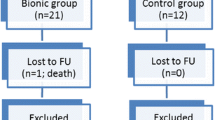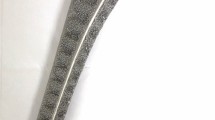Abstract
The clinical results after total hip replacements using noncemented stems have shown considerable variability over the years; the design and characteristics of the implant seemed to play a role in explaining this fact. The purpose of this paper is to report the clinical, radiographic and densitometry results of total hip arthroplasties using a stem designed for noncemented implantation and to engage and load the femur proximally. Fifty-eight consecutive patients (62 hips) followed for an average of 4.3 years (range 36–70 months) were clinically and radiographically followed up at three weeks, three months, six months, one year, and yearly thereafter. The average pre-operative Harris hip score was 49 increasing to 98 at the latest follow-up. There were no cases of aseptic or septic loosening. The average subsidence at three years was 0.45 mm (SD ± 0.36 mm). Radiographically all hips were classified as stable, and evident changes compatible with new bone apposition were observed in 64% of the cases. The extended proximal geometry of the device seems to favour initial and secondary stability as reflected by the low subsidence values over time. The maintenance of periprosthetic bone stock and the absence of stress shielding can be explained by the predominantly proximal loading pattern of the stem.
Résumé
Les résultats cliniques des arthroplasties totales de hanche utilisant des tiges non-cimentées ont été très variables au cours des années, les caractéristiques de l’implant semblant jouer un rôle important. Le but de ce travail est de rapporter les résultats cliniques et radiologiques d’arthroplasties avec une tige non-cimentée avec appui proximal. 58 patients consécutifs (62 hanches) suivi en moyenne pendant 4,3 ans (36 à 70 mois) étaient étudiés à 3 semaines, 3 mois, 6 mois, 1 an puis tous les ans. Le score moyen de Harris pré-opératoire était de 49, augmentant à 98 au dernier examen. Il n’y avait pas de descellement aseptique ou septique. L’enfoncement moyen à 3 ans était de 0,45 mm (SD 0,36 mm). Radiologiquement toutes les hanches étaient stables et des modifications compatibles avec une ostéoformation était visible dans 64% des cas. La géométrie proximale de la tige semble favoriser la stabilité initiale et secondaire comme le montre le faible enfoncement au fil du temps. La conservation du stock osseux et l’absence de déviation des contraintes peuvent s’expliquer par la mise en charge proximale de la prothès.



Similar content being viewed by others
References
Bourne RB, Rorabeck CH, Ghazal ME, Lee MH (1994) Pain in the thigh following total hip replacement with a porous-coated anatomic prosthesis for osteoarthrosis. A five-year follow-up study. J Bone Joint Surg Am 76:1464–1470
Callaghan JJ, Dysart SH, Savory CG (1988) The uncemented porous-coated anatomic total hip prosthesis. Two-year results of a prospective consecutive series. J Bone Joint Surg Am 70:337–346
Capello WN, Sallay PI, Feinberg JR (1994) Omniflex modular femoral component. Two- to five-year results. Clin Orthop 298:54–59
Claus AM, Hopper RH Jr, Engh CA (2002) Fractures of the greater trochanter induced by osteolysis with the anatomic medullary locking prosthesis. J Arthroplasty 17:706–712
Dorr LD, Wan Z (1996) Comparative results of a distal modular sleeve, circumferential coating, and stiffness relief using the Anatomic Porous Replacement II. J Arthroplasty 11:419–428
Duffy P, Sher JL, Partington PF (2004) Premature wear and osteolysis in an HA-coated, uncemented total hip arthroplasty. J Bone Joint Surg Br 86:34–38
Engh CA, Bobyn JD, Matthews JG 2nd (1984) Biologic fixation of a modified Moore prosthesis. Part I. Evaluation of early clinical results. Hip 1984:95–110
Engh CA, Massin P (1989) Cementless total hip arthroplasty using the anatomic medullary locking stem. Results using a survivorship analysis. Clin Orthop 249:141–158
Fetto J, Bettinger P, Austin K et al (1995) Re-examination of hip biomechanics during unilateral stance. Am J Orthop 1995:605–612
Fetto J, Leali A, Moroz A (2002) Evolution of the Koch model of the biomechanics of the hip: clinical perspective. J Orthop Sci 7:724–730
Giannikas KA, Din R, Sadiq S, Dunningham TH (2002) Medium-term results of the ABG total hip arthroplasty in young patients. J Arthroplasty 17:184–188
Gruen TA, McNeice GM, Amstutz HC (1979) “Modes of failure” of cemented stem-type femoral components: a radiographic analysis of loosening. Clin Orthop Relat Res 141:17–27
Hernandez-Vaquero D, Murcia-Mazon A, Paz-Jimenez J, Alegre-Mateo R, Martinez-Garcia J, Pena-Vazquez J (1999) Behavior of the femoral stem in the Bihapro hip prosthesis. Orthopedics 22:1049–1053
Kim YH, Oh SH, Kim JS (2003) Primary total hip arthroplasty with a second-generation cementless total hip prosthesis in patients younger than fifty years of age. J Bone Joint Surg Am 85A:109–114
Lavernia C, D’Apuzzo M, Hernandez V, Lee D (2004) Thigh pain in primary total hip arthroplasty: the effects of elastic moduli. J Arthroplasty 19:10–16
Leali A, Fetto J, Insler H (2006) Favorable midterm results of total hip arthroplasties with a lateral flare uncemented stem. Clin Orthop Relat Res (in press)
Leali A, Fetto J, Insler H, Elfenbein D (2002) The effect of a lateral flare feature on implant stability. Int Orthop 26:166–169
Markolf KL, Amstutz HC, Hirschowitz DL (1980) The effect of calcar contact on femoral component micromovement. A mechanical study. J Bone Joint Surg Am 62:1315–1323
Martell JH, Galante JO, Pierson RH, Jacobs JJ, Rosenberg AG, Maley M (1992) Clinical experience with primary cementless total hip arthroplasty. Chir Organi Mov 77:383–396
McAuley JP, Culpepper WJ, Engh CA (1998) Total hip arthroplasty. Concerns with extensively porous coated femoral components. Clin Orthop 355:182–188
Meding JB, Ritter MA, Keating EM, Faris PM (1994) Clinical and radiographic evaluation of long-stem femoral components following revision total hip arthroplasty. J Arthroplasty 9:399–408
Rosenthall L, Bobyn JD, Tanzer M (1999) Bone densitometry: influence of prosthetic design and hydroxyapatite coating on regional adaptive bone remodelling. Int Orthop 23:325–329
Van Wellen P, Demuynck M, Haentjens P, De Valkeneer O, Casteleyn PP, Vanden Berghe I, Opdecam P, Kesteleyn P (1993) Total hip arthroplasty with the porous-coated anatomic (PCA) prosthesis: the femoral component. Acta Orthop Belg 59(Suppl 1):282–286
Walker PS, Culligan SG et al (1999) The effect of a lateral flare feature on uncemented hip stems. Hip Int 9:71–80
Walker PS, Culligan SG, Hua J, Muirhead-Allwood SK, Bentley G (2000) Stability and bone preservation in custom designed revision hip stems. Clin Orthop 373:164–173
Walker PS, Mai SF, Cobb AG, Bentley G, Hua J (1995) Prediction of clinical outcome of THR from migration measurements on standard radiographs. A study of cemented Charnley and Stanmore femoral stems. J Bone Joint Surg Br 77:705–714
Zerahn B, Storgaard M, Johansen T, Olsen C, Lausten G, Kanstrup IL (1998) Changes in bone mineral density adjacent to two biomechanically different types of cementless femoral stems in total hip arthroplasty. Int Orthop 22:225–229
Author information
Authors and Affiliations
Corresponding author
Additional information
Level of evidence: Therapeutic study, level IV (case series).
Rights and permissions
About this article
Cite this article
Leali, A., Fetto, J. Promising mid-term results of total hip arthroplasties using an uncemented lateral-flare hip prosthesis: a clinical and radiographic study. International Orthopaedics (SICO 31, 845–849 (2007). https://doi.org/10.1007/s00264-006-0267-8
Received:
Revised:
Accepted:
Published:
Issue Date:
DOI: https://doi.org/10.1007/s00264-006-0267-8




